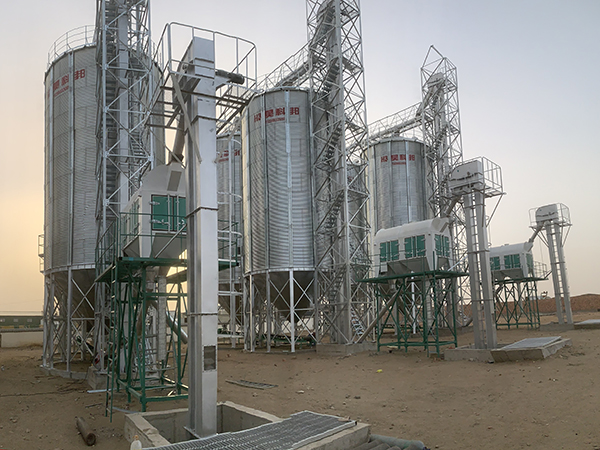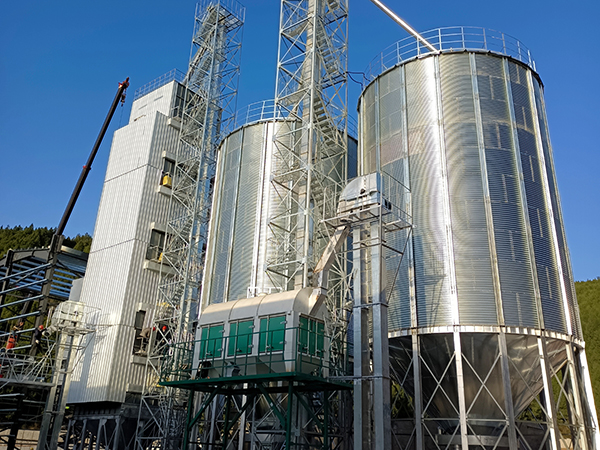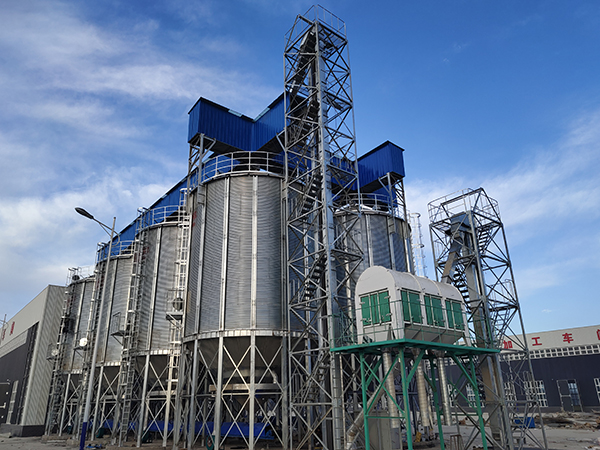malt grain silo
A malt grain silo is a facility specifically designed for storing malt. Malt is a food ingredient made by soaking, germinating, and drying barley or other grains
malt grain silo Introduction
A malt grain silo is a facility specifically designed for storing malt. Malt is a food ingredient made by soaking, germinating, and drying barley or other grains, commonly used in brewing beer, making malt beverages, and food production. Malt grain silos typically have adequate ventilation, moisture control, and moisture-proofing functions to ensure the quality and safety of malt, preventing mold and other quality issues during storage. They play a crucial role in the brewing industry and food processing sector, ensuring the supply and quality of malt, serving as essential facilities.

Characteristics of malt grain silo
Large Capacity Storage
Purpose-built with substantial storage volume, malt silos accommodate substantial quantities of the crop in a centralized manner, catering to the demands of large-scale agricultural operations and enhancing warehouse efficiency and spatial utilization.
Superior Sealability
The silo structure is meticulously crafted to ensure an exceptional level of airtightness, preventing external moisture, pests, and contaminants from infiltrating and safeguarding the malt against moisture damage, mold growth, and infestations.
Advanced Ventilation System
Incorporating state-of-the-art ventilation technology, the silo facilitates the regulation of internal temperature and humidity, mitigating the risk of overheating and spoilage while fostering an optimal storage atmosphere for the preservation of malt quality.
Integrated Pest Management
Equipped with integrated pest management strategies, such as the installation of insect-proof screens, fumigation facilities, and regular inspections, the silo effectively combats potential pest infestations, protecting the malt from damage and maintaining its integrity.
Smart Monitoring
Modern malt silos often feature intelligent monitoring systems comprising temperature and humidity sensors, carbon dioxide detectors, and grain moisture meters, which continually monitor and record environmental parameters within the silo, providing real-time data for informed decision-making in grain storage management.
Efficient Material Handling Equipment
To streamline the loading and unloading processes, malt silos are fitted with efficient material handling equipment, including conveyors, elevators, and cleaning sieves, which ensure rapid, damage-free transfer of malt while minimizing manual labor requirements and enhancing overall operational efficiency.
Fire Safety Measures
Comprehensive fire safety provisions, such as fire extinguishers, fire hydrants, and automatic fire suppression systems, are incorporated into the design of malt silos to ensure compliance with stringent fire safety regulations and provide peace of mind against potential fire hazards.
Structural Robustness
With a robust and durable structural design, malt silos are built to withstand the considerable weight of stored malt, as well as the rigors of diverse weather conditions, including wind, snow, and earthquakes, ensuring long-lasting, secure storage.
In summary, malt silos excel in offering large-capacity storage, superior sealability, advanced ventilation, integrated pest management, smart monitoring, efficient material handling, fire safety measures, and structural robustness, making them the ideal storage solution within the malt supply chain.


Structure of malt grain silo
Roof
The roof is the structure that covers the top of the grain silo, providing shelter for the stored malt and protecting it from direct exposure to the elements such as rain and sunlight.
Walls
The walls are the vertical sides of the grain silo that come into direct contact with the stored malt and must withstand the lateral pressure exerted by the malt.
Support Structure
This refers to the structural support beneath the body of the silo, above the foundation, which bears the weight of the silo itself as well as the malt stored within.
Foundation
The foundation is the base structure that supports the entire silo, designed to sustain the combined weight of the silo structure and the malt, ensuring stability.
Inlet and Outlet Systems
This includes the conveyance equipment and loading facilities used to fill the silo with malt and to discharge it, an integral part of the silo’s operation.
Ventilation System
To keep the malt fresh and prevent spoilage, a silo requires an effective ventilation system to control the temperature and humidity within the storage environment.
Safety and Monitoring Systems
These include detection and control systems for monitoring the storage conditions of the malt and the operational status of the silo, ensuring storage safety.
Ancillary Facilities
Such as weighing systems, cleaning, and sorting equipment, which help maintain the quality of the malt and the efficient operation of the silo.
These components together form the structural system of a malt grain silo, ensuring that malt can be safely stored under appropriate conditions. When designing, considerations must also be given to factors such as the silo’s capacity, geographical location, building codes, and intended service life.


Advantages of malt grain silo
Efficient Storage
Malt grain silo are designed to store large quantities of malt efficiently, which is particularly important for large breweries to save space and improve the efficiency of raw material management.
Preservation of Malt Quality
By controlling the environment within the silo, malt silos help protect the malt from factors such as moisture, excessive dryness, pests, and other elements that could affect its quality.
Reduction of Losses
Through scientific storage and management, malt grain silo can reduce losses of malt due to spoilage, pest damage, or improper handling.
Facilitation of Automation
The design of malt grain silos is usually conducive to the implementation of automated in-feed and out-feed systems, reducing labor costs and improving operational efficiency.
Structural Stability
In accordance with the “Code for Design of Grain Flat Storage” (GB 50320-2014), the structural design of malt grain silo can withstand the load of the grain and the base of the column, ensuring the stability and safety of the structure.
Ease of Maintenance
The design and material selection of modern malt grain silos make them easier to maintain and clean, helping to keep the malt hygienic and of high quality.
Adaptability
Malt grain silo can be designed to suit different geographical environments and climatic conditions, meeting various storage requirements.
Cost-Effectiveness
Although the initial investment may be high, malt grain silos provide good cost-effectiveness in the long term by reducing losses and improving efficiency.
Environmental Control
The silos can be equipped with advanced ventilation and temperature-humidity control systems to maintain the best storage conditions for malt.
Scalability
The design of malt grain silo allows for expansion according to the growth of production needs, adding flexibility.
Compliance with Standards
The design and construction of malt silos follow relevant national and industry standards, such as the “Standard for the Construction of Grain Warehouses” (Jianbiao 172-2016), ensuring their quality and compliance.
Innovative Technology
New types of underground silo structural design schemes use prefabricated and composite structural technologies, providing more room for innovation and improvement.
These advantages make malt silos an ideal choice for malt storage in the beer production industry and other sectors that use malt.
Application scope of malt grain silo
Coban Silo is widely used for grain storage such as wheat, corn, soybean, paddy, rice, soybean meal, barley, malt, sunflower seeds, rapeseed, peanuts, flour, and other powder materials, oat, special Silo, and seeds, etc.

Malt grain silo technical parameters
Scientifically speaking, the Silo capacity should be measured with volume (m3). Even in the same grain Silo, the storage tons will be different for different grains with different densities. The following table is calculated based on a Silo density of 0.75kg/m3, and surely HKB customizes Silo systems unique for you.
| Most Popular Hopper Bottom Steel Silo Technical Specifications | ||||||||
| Capacity | 50Ton | 100Ton | 150Ton | 200Ton | 300Ton | 500Ton | 1000Ton | 1500Ton |
| Model | TCZK
03605 |
TCZK
04507 |
TCZK
05507 |
TCZK
06406 |
TCZK
07307 |
TCZK
07313 |
TCZK
11010 |
TCZK
12811 |
| Diameter(m) | 3.667 | 4.584 | 5.500 | 6.417 | 7.334 | 7.334 | 11.000 | 12.834 |
| Total Height(m) | 9.56 | 12.53 | 13.25 | 12.85 | 14.70 | 21.42 | 20.95 | 23.51 |
| Volume(m³)
Density:0.75ton/m³ |
69 | 150 | 222 | 273 | 415 | 699 | 1346 | 2039 |
| Most Popular Flat Bottom Steel Silo Technical Specifications | ||||||||
| Capacity | 1000Ton | 1500Ton | 2000Ton | 2500Ton | 3000Ton | 5000Ton | 8000Ton | 10000Ton |
| Model | TCK
10014 |
TCK
11915 |
TCK
13715 |
TCK
15514 |
TCK
15518 |
TCK
18321 |
TCK
24718 |
TCK
25621 |
| Diameter(m) | 10.084 | 11.918 | 13.750 | 15.584 | 15.584 | 18.334 | 24.751 | 25.668 |
| Total Height(m) | 18.69 | 20.34 | 20.87 | 20.30 | 24.78 | 28.60 | 26.99 | 30.60 |
| Volume(m³)
Density: 0.75ton/m³ |
1335 | 2009 | 2701 | 2467 | 4145 | 6693 | 10879 | 13484 |
After-sale Service
- – HKB provides advanced grain safety storage technology to assure your grain silo 100% quality stability.
- – grain silo Quality guarantee is one year after installation and commissioning or 18 months after leaving China Port. Maturity is the first.
- – 7 days x 24 hours service, within 24 hours reply/solve of any technical issues upon request.
- – Routinely telephone track to remove all might be problems grain silo or issues guarantying the whole system grain silo long-lasting safety and reliability.
- – HKB will consider all other needs like customs clearance, sea delivery, insurance, customs tax benefit plan, documentation, etc. So our respected Users feel so relaxed and easy to get the grain silo system well.









